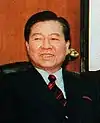Democratic Party (South Korea, 1991)
The Democratic Party (Korean: 민주당) was a political party of South Korea from 1991 to 1995.
Democratic Party 민주당 | |
|---|---|
.svg.png.webp) | |
| Abbreviation | DP |
| President | Kim Dae-jung (1991-1992) |
| Founded | 16 September 1991 |
| Dissolved | 21 December 1995 |
| Merger of | New Democratic Unionist Party Democratic Party |
| Merged into | National Congress for New Politics (majority) United Democratic Party (minority) |
| Ideology | Liberalism Social conservatism |
| Political position | Centre |
| Colours | Red Green Blue (customary) |
| National Assembly (1992 election results) | 97 / 299
|
History
The party was formed by the merger of New Democratic Unionist Party (NDUP) of Kim Dae-jung, and Democratic Party of Lee Ki-taek (aka Little Democrats), as a part of the opposition union. During that time, NDUP, the main opposition, faced a difficulties after they lost in 1991 local elections. Little Democratic Party, a splinter group formed by the dissidents of Kim Young-sam's United Democratic Party, was struggling with its few seats.
On 16 September 1991, both parties declared to be combined and re-founded as Democratic Party.[1] Both Kim Dae-jung (DJ; Chairman of NDUP) and Lee Ki-taek (KT; Chairman of Little Democrats), was elected as the Co-Presidents of the new party.[1]
Prior to the presidential election in 1992, DJ defeated Lee and elected as the party's presidential candidate. He was widely criticised for calling rural voters as "pro-Democratic Liberal Party (DLP; the then ruling party)" and/or "pro-Roh Tae-woo",[2] and lost to DLP's Kim Young-sam. DJ subsequently resigned his party presidency and retired from the politics.[3] KT then solely elected as the new president on 11 March 1993.[4]
The party then absorbed New Korea Party of Lee Jong-chan in the early 1995,[5] and won the local elections in 1995.[6] However, shortly after, DJ officially returned to politics, and conflicts were sparked.[7] The party's pro-DJ factions, not excluding DJ himself, left and founded a new party, named National Congress for New Politics (NCNP).[8] On 21 December, the party merged with New Party for Reform, and re-built as United Democratic Party, who then became one of the predecessor of the incumbent Liberty Korea Party.
Leadership
Party Presidents
| No. | President(s) | Period |
|---|---|---|
| 1 | Kim Dae-jung Lee Ki-taek | 16 September 1991 – 11 March 1993[lower-alpha 1] |
| 2 | Lee Ki-taek | 11 March 1993 – 28 August 1995 |
| 3 | Hong Young-ki Park Il | 29 August 1995 – 14 December 1995 |
- Kim Dae-jung resigned on 18 December 1992 due to the election defeats.
Election results
Presidential election
| Election | Candidate | Total votes | Share of votes | Outcome | |
|---|---|---|---|---|---|
| 1992 | Kim Dae-jung |  |
8,041,284 | 33.82% | Lost |
Legislative elections
| Election | Total seats won | Total votes | Share of votes | Outcome of election | Status | Election leader |
|---|---|---|---|---|---|---|
| 1992 | 97 / 299 |
6,004,578 | 29.2% | (Democrats-RNP) |
Opposition | Kim Dae-jung Lee Ki-taek |
Local election
| Election | Metropolitan mayor/Governor | Provincial legislature | Municipal mayor | Election leader |
|---|---|---|---|---|
| 1995 | 4 / 15 |
333 / 970 |
84 / 230 |
Lee Ki-taek |
References
- "민주당 공식출범". 16 September 1991. Retrieved 9 September 2019.
- "후보가 유세장서 「유권자 비판」". 5 December 1992. Retrieved 9 September 2019.
- "김대중씨 "정계은퇴 선언" 안팎". 19 December 1992. Retrieved 9 September 2019.
- "민주당 새대표 이기택씨". 12 March 1993. Retrieved 9 September 2019.
- "민주, 새한국당—재야 통합 전당대회". 25 February 1995. Retrieved 9 September 2019.
- "부산 文正秀 경남 金爀珪씨 당선". 28 June 1995. Retrieved 9 September 2019.
- "민주, 새한국당—재야 통합 전당대회". 18 July 1995. Retrieved 9 September 2019.
- "새정치국민회의 창당…제1야당 출범 김대통령에 회담 제의". 6 September 1995. Retrieved 9 September 2019.